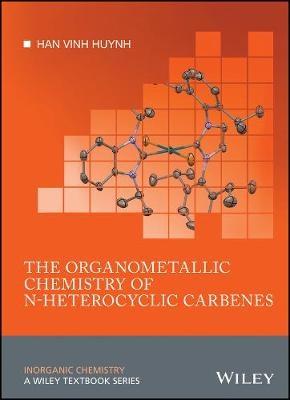
The Organometallic Chemistry of N–heterocyclic Carbenes
John Wiley & Sons Inc (Hersteller)
978-1-118-69878-5 (ISBN)
- Keine Verlagsinformationen verfügbar
- Artikel merken
Topics covered include: - Stabilization, dimerization and decomposition of NHCs - Stereoelectronic properties of NHCs and their evaluation - Diversity of NHCs - Isomers of NHC complexes and their identification - NMR spectroscopic signatures of NHC complexes - normal, abnormal and mesoionic NHCs The Organometallic Chemistry of N-heterocyclic Carbenes is an essential resource for all students and researchers interested in this increasingly important and popular field of research.
HAN VINH HUYNH Department of Chemistry, National University of Singapore, Republic of Singapore
Foreword ix Preface x List of Abbreviations and Definitions xii 1 General Introduction 1 1.1 Definition of Carbenes 1 1.2 Historical Overview of Carbenes, N-Heterocyclic Carbenes, and Their Complexes 3 1.2.1 The Quest for Free Stable Carbenes 3 1.2.2 The Quest for Carbene Complexes 11 References 15 2 General Properties of Classical NHCs and Their Complexes 17 2.1 Stabilization in NHCs (Push-Pull Effect) 19 2.2 Backbone Differences and Their Implications 20 2.3 Dimerization of Carbenes 22 2.4 Nomenclature of N-Heterocyclic Carbenes 25 2.5 Electronic Properties of NHCs and Different Electronic Parameters 29 2.5.1 Tolman s Electronic Parameter (TEP) and Related Carbonyl Based Systems 29 2.5.2 Lever s Electronic Parameter (LEP) 36 2.5.3 Huynh s Electronic Parameter (HEP) 38 2.6 Steric Properties of NHCs 42 2.7 Structural Diversity of NHC Ligands and Their Complexes 45 2.7.1 Donor-Functionalized NHCs 45 2.7.2 Multidentate NHCs 46 2.7.3 Pincer-Type NHC Ligands 47 2.7.4 Tripodal and Macrocyclic Ligands 48 References 49 3 Synthetic Aspects 52 3.1 General Routes to Azolium Salts as NHC Precursors 52 3.1.1 N-Alkylation of Neutral Azoles 52 3.1.2 Multicomponent Condensation Reactions 55 3.1.3 Cyclization of Diamines 58 3.1.4 Cyclization of Formamidines 64 3.2 General Routes to Free NHCs 66 3.2.1 NHCs via Deprotonation of Azolium Salts 68 3.2.2 NHCs via Reduction of Thiones 71 3.2.3 NHCs via -Elimination of Small Molecules 73 3.3 General Synthetic Routes to NHC Complexes 74 3.3.1 Coordination of Free NHCs 76 3.3.2 Cleavage of Electron-Rich Entetramines by Transition Metals 78 3.3.3 In Situ Deprotonation of Azolium Salts in the Presence of Transition Metals 78 3.3.4 Carbene Transfer Routes 81 3.3.5 Oxidative Addition of an Azolium Salt to a Low-Valent Metal Complex 83 3.3.6 Metal-Template Synthesis Using Isocyanide Complexes as Precursors 85 3.3.7 NHC Complexes by Small Molecule Elimination 89 3.3.8 NHC Complexes by Protonation/Alkylation of Azolyl Complexes 93 References 95 4 Group 10 Metal(0)-NHC Complexes 99 4.1 Nickel(0)-NHC Complexes 99 4.1.1 Reactions of Enetetramines and Free NHCs 99 4.1.2 Reduction of Nickel(II)-NHC Complexes 106 4.2 Palladium(0)-NHC Complexes 107 4.2.1 Reactions of Free NHCs 107 4.2.2 Reduction of Palladium(II)-NHC Complexes 112 4.3 Platinum(0)-NHC Complexes 115 4.3.1 Homoleptic Complexes 115 4.3.2 Heteroleptic Complexes 117 References 120 5 Group 10 Metal(II)-NHC Complexes 122 5.1 Nickel(II)-NHC Complexes 122 5.1.1 Cleavage of Enetetramines and the Free Carbene Route 122 5.1.2 In Situ Deprotonation of Azolium Salts with Basic Metal Salts 124 5.1.3 The Silver-Carbene Transfer Route 127 5.2 Palladium(II)-NHC Complexes 129 5.2.1 Cleavage of Entetramines and the Free Carbene Route 130 5.2.2 In Situ Deprotonation of Azolium Salts with External Base 133 5.2.3 The Palladium Acetate Route 135 5.2.4 The Silver-Carbene Transfer Route 139 5.2.5 Isomers of Bis(NHC) Palladium(II) Complexes 143 5.3 Platinum(II)-NHC Complexes 150 5.3.1 Cleavage of Entetramines 151 5.3.2 Cyclization of Isocyanide Complexes 152 5.3.3 The Oxidative Addition Route 153 5.3.4 The Free Carbene Route 157 5.3.5 In Situ Deprotonation of Azolium Salts with External Base 159 5.3.6 In Situ Deprotonation with Basic Platinum Precursors 162 5.3.7 Carbene Transfer Reactions 164 References 168 6 Group 11 Metal-NHC Complexes 171 6.1 Copper(I)-NHC Complexes 171 6.1.1 The Free Carbene Route 171 6.1.2 Alkylation of Copper-Azolate Complexes 172 6.1.3 In Situ Deprotonation with External Base 173 6.1.4 In Situ Deprotonation with Basic Copper Precursors 177 6.1.5 The Silver Carbene Transfer Route 180 6.1.6 The Copper Powder Route 182 6.2 Silver(I)-NHC Complexes 183 6.2.1 The Free Carbene Route 183 6.2.2 In Situ Deprotonation with Basic Silver Precursors 186 6.2.3 Silver-Carbene Transfer Reactions 192 6.3 Gold(I)-NHC Complexes 194 6.3.1 Cleavage of Enetetramines 194 6.3.2 Protonation/Alkylation of Azolato Complexes 194 6.3.3 The Free Carbene Route 196 6.3.4 The Silver-Carbene Transfer Route 200 6.3.5 Ligand Redistribution and Autoionization of Gold(I) NHC Complexes 210 6.4 Gold(III)-NHC Complexes 212 References 218 7 Ruthenium, Rhodium, and Iridium Metal-NHC Complexes 220 7.1 Ruthenium(II)-NHC Complexes 220 7.1.1 Cleavage of Enetetramines and the Free Carbene Route 220 7.1.2 In Situ -Elimination 227 7.1.3 In Situ Deprotonation of Azolium Salts 228 7.1.4 The Silver-Carbene Transfer Route 230 7.2 Rhodium(I)- and Rhodium(III)-NHC Complexes 232 7.2.1 Cleavage of Enetetramines and the Free Carbene Route 232 7.2.2 In Situ Deprotonation of Azolium Salts 238 7.2.3 The Silver-Carbene Transfer Route 243 7.3 Iridium(I)- and Iridium(III) NHC Complexes 245 7.3.1 Cleavage of Enetetramines and the Free Carbene Route 245 7.3.2 In Situ -Elimination 250 7.3.3 In Situ Deprotonation of Azolium Salts 251 7.3.4 The Silver-Carbene Transfer Route 256 References 261 8 Beyond Classical N-heterocyclic Carbenes I 263 8.1 N,S-Heterocyclic Carbenes (NSHCs) 263 8.2 N,O-Heterocyclic Carbenes (NOHCs) 270 8.3 Expanded Six-Membered NHCs 277 8.4 Expanded Seven- and Eight-Membered NHCs 282 8.5 Expanded Diamidocarbenes (DAC) 287 References 291 9 Beyond Classical N-heterocyclic Carbenes II 293 9.1 Abnormal Imidazolin-4/5-ylidenes (aNHC) 294 9.2 Mesoionic 1,2,3-Triazolin-5-ylidenes (MIC) 303 9.3 Pyrazolin-3/5-ylidenes (Pyry) and Indazolin-3-ylidenes (Indy) 310 9.3.1 Pyrazolin-3/5-ylidenes 310 9.3.2 Indazolin-3-ylidenes 317 9.4 Cyclic (Alkyl)(Amino)Carbenes (CAACs) Or Pyrrolidin-2-ylidenes 320 9.5 Remote N-Heterocyclic Carbenes (rNHC) 324 9.5.1 Pyridin-3/4-ylidenes 324 9.5.2 Pyrazolin-4-ylidenes 326 References 328 Index 330
| Verlagsort | New York |
|---|---|
| Sprache | englisch |
| Maße | 152 x 229 mm |
| Gewicht | 666 g |
| Themenwelt | Naturwissenschaften ► Chemie ► Organische Chemie |
| ISBN-10 | 1-118-69878-9 / 1118698789 |
| ISBN-13 | 978-1-118-69878-5 / 9781118698785 |
| Zustand | Neuware |
| Informationen gemäß Produktsicherheitsverordnung (GPSR) | |
| Haben Sie eine Frage zum Produkt? |